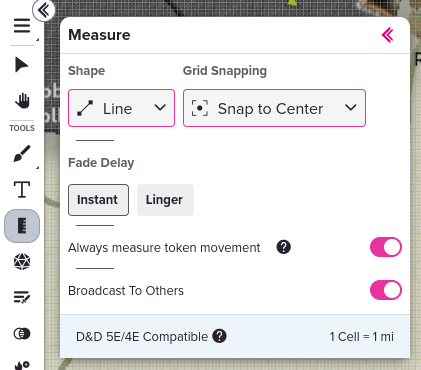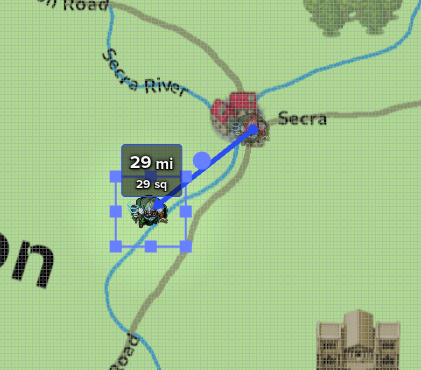Anytime you travel from one location to another, such as leaving a town to go to a castle or explore a dungeon, or even go to another town, you will be traveling on the world map. World Maps are basically maps that cover large areas and is usually measured in miles. Your GM should have prepared for you a world map, either drawn by the GM or downloaded from here.
Back to top1) Movement on the World Map
When moving on the world map, you will refer to your character's world movement rate. The world map is a map of a large area, typically a national map or a continental map. Despite its name, the world map is likely not to consist of the entire game world. A world maps is simply a map which covers a very large area.
Legends of Nor’Ova requires using a ruler with a map. The movement on the world map is measured using millimeters, however if you are designing your own world you can use any form of measurement. You could also opt to use grid based movement, it will work just the same.
When traveling on the world map, when you have traveled the entire amount of your world movement rate, you have traveled for one 10-hour cycle. That means if your character has a world movement rate of 2, then your character would move 2 millimeters on a ruler or 2 miles in that ten hour time frame.
World Movement is measured in miles per 10-hour cycle. That means that your World Movement rate is how far your character can travel in the world map in miles per cycle.
Since you are likely playing in a group with other characters, the world movement rate of your party will be determined by the slowest character, or the character with the slowest world movement rate. This is done so that the group can travel together. It is much easier to imagine having to slow your pace for a slower member of the party than to try and explain how and why a person with a world movement rate of 2 can keep up with a person with a world movement rate of 4.
1.1) World Movement on roll20
If you are playing this using the virtual table top, roll20, it has a built in ruler for you.
First you will want to ensure that the ruler is set to be used when you move your token. This might be a setting that the GM has already activated.

Then when you drag or move your token on the map it will show movement with a blue line from your starting place.

You can only move as far as you have rolled. To roll for movement you would click the dice icon on your roll20 character sheet next to move. It will display for you in chat what is rolled, showing you how far you can move in miles.
1.2) Using Movement Abilities in World Movement
Of course you will not always be walking when in world movement. You might decide to run some, or you may have to climb through a mountain range or swim across a raging river. Therefore you may find yourself needing to use a movement ability. Typically, these would be climbing, swimming, and run. Some races may have their own movement abilities, such as short range teleport or flying. Sprint, however, is one movement ability that you cannot use in world movement. Below are the main movement skills that you may need to use, and how they work for world movement. Some movement abilities are abilities that all characters have such as running.
- Climbing: There are various situations in which you might need to climb, and the Climbing Ability has specializations to cover these. The specializations are: Mountain, Cliff, Tall Tree, and Flat Wall. There is no need for climbing ability for easy to climb trees and other areas that can be climbed without training. Each specialization grants you the ability to climb those difficult to climb situations at the Power cost of climbing. The Endurance cost depends on the difficulty of the climbing environment.
- Simple Climb: 2 Power per movement; movement decreased by 1
- Average Climb: 4 Power per movement; movement decreased by half
- Hard Climb: 8 Power per movement; movement decreased to 1
- Challenging Climb: 12 Power per movement; movement decreased to 1 every 2 hours
- Nearly Impossible Climb: 16 Power per movement; movement decreased to 1 every 3 hours
- Swimming: As long as you are unarmored, you can swim. Everyone in Nor'Ova has basic swimming ability. If you are wearing armor, you will need the Swimming While Armored ability. Swimming does cost Endurance and can impact your world movement rate, depending upon the swimming environment.
| Ability | Effects | Requirements |
|---|---|---|
| Swimming While Armored | +1 to athletics for checks to swim while armored. |
Skillful Climbing |
- Wading: You aren't really swimming as you can reach bottom. Your world movement is decreased by 1.
- Gentle Waters: A still pond or a creek with barely any current, this water is easy to swim in. 1 Power per movement, world movement decreased by 1.
- Average Currents: a river with a steady current, 2 Power per movement. If moving with current world movement increased by 1. If going against the current world movement decreased by half.
- Rapids: heavy currents, 4 Power Endurance per movement and Acrobatics Checks may be required to keep swimming and not drown. If moving with current world movement increased by 2. If going against the current world movement decreased to 1.
- Run: You can run over long distances. Every character can. You simply use 2 Power per movement that you run, increasing your world movement rate by half. If you are running downhill, increase movement rate by an additional half.
- Racial Movement Abilities or Skills: You can use any racial movement skill such as fly or teleport. Their effect and cost is once per hour.
1.3) Traveling Across Difficult Terrain
Rarely will you ever have nothing but good roads and smooth plains when traveling the world. You will most likely have to deal with some kind of harsh or difficult terrain which would slow you down. Therefore it is important to be able to deal with such terrain. Below is a table that lists the different types of terrains with a small description and how they affect your world movement rate.
Terrain Penalty Table
| Terrain Type | Description | World Movement Modifiers |
| Flat & Rolling Plains | Any type of plains, flat, or with gentle rolling hills and slopes. Grass or dirt covered. | no movement penalties or bonuses |
| Roads | Well defined and maintained roads, not poorly maintained or ruined. | increase your world movement rate by + 1 |
| Steep Hills | Tall hills with steep slopes that are hard to travel across. | decrease your world movement rate by 1 |
| Swamp | A body of shallow water that is thick with mud and other substances, that is no deeper than waist deep. Also referred to as a bog or everglades. | decrease your world movement rate by 2 |
| Sand | Sand that is at least 2 inches deep and covers the entire ground such as a beach or a desert. | decrease your world movement rate by 1 |
| Mud | Large areas of thick and soft mud which a traveler's feet could sink into. | decrease your world movement rate by 2 |
| Thick Underbrush | Bushes, ivy, and other plants that come up no higher than to your chest. | decrease your world movement rate by 1 |
| Forest | Any area that is listed as a forest , jungle, or wood land. | decrease your world movement rate by 2 |
| Shallow Snow | Snow which covers the entire ground that is deeper than one inch but no deeper than 4 inches. | decrease your world movement rate by 1 |
| Deep Snow | Snow which covers the entire ground and is deeper than 4 inches.. | decrease your world movement rate by ½ |
| Ice | A layer of ice which covers the entire ground. | decrease your world movement rate by ½ |
It should be noted that it is to the GM’s discretion on what the terrain is, and the players should defer to the GM.
Back to top2) 2. Camping
Should you not make it to your destination within two movement cycles, you will most likely need to camp. Camping allows you to rest and regather some of your lost energy. Most races require rest. When you stop to make camp, you will need to remove from your inventory any food and water for that day.
Your GM may use this time to also plan a battle or check for a random battle. More on this is in the section entitled Combat.
Every hour of sleep restores your Vitality, Soul, and Power by the secondary Gen Dice. On roll20 character sheet you can use the dice icon next to each gen dice. In chat you will see how much of that stat you recover by each hour you get to sleep. Obviously you can not recover past your full stat.
Back to top3) 3. Foraging, Hunting, & Fishing
Another use for camping is the gathering of food and materials. Foraging, hunting, and fishing are all appropriate activities that your character can engage in during a camping cycle, and you may decide to use a second camping cycle or an entire game day for these activities.
- Foraging: For each hour of the camping cycle you are allowed to make checks to find berries and materials. You may use the alchemical ingredients or the materials list in the equipment section of this book, or the GM may create his own list of things that you can find while foraging. The check depends on the situation and is up to the GM.
- Hunting: To hunt you will need to use the ability called “Hunting”. You will have a chance each hour of the cycle to use this skill, and with each successful use of this skill you will be rewarded a small, killed animal of the GM’s choosing.
- Fishing: To fish you will need to be near a body of water and have fishing gear; a pole, fishing line, fishing hooks, and bait. You will throw your line in and for each hour of the cycle you will be allowed to make a luck check. A successful luck check will win you 1d4 fish.
